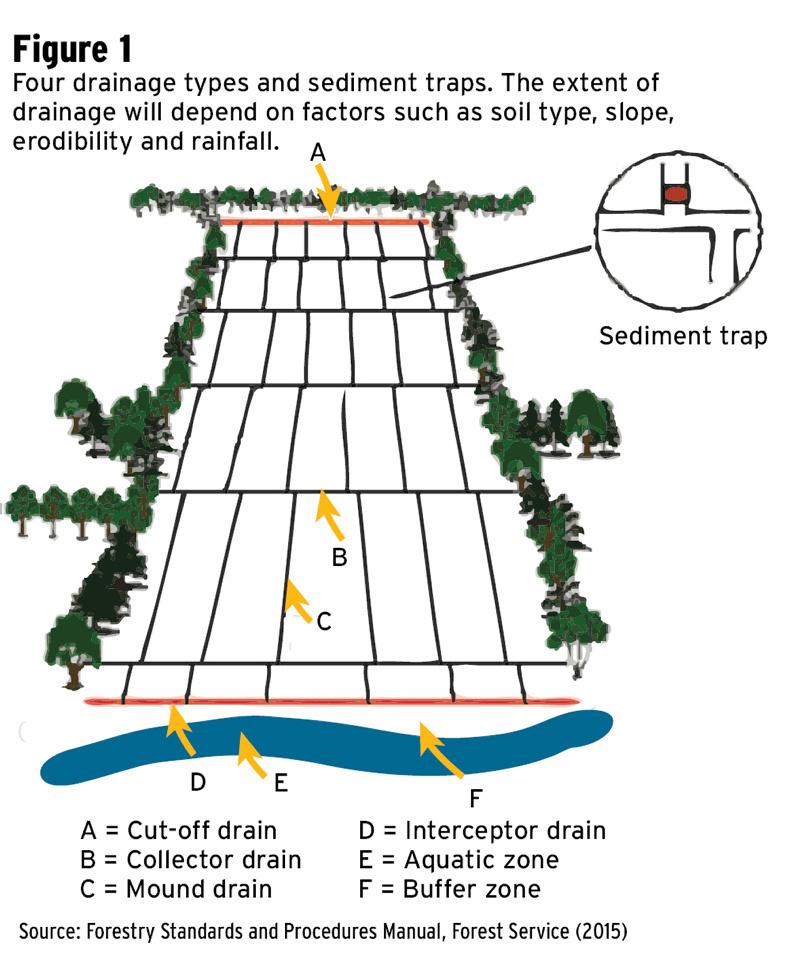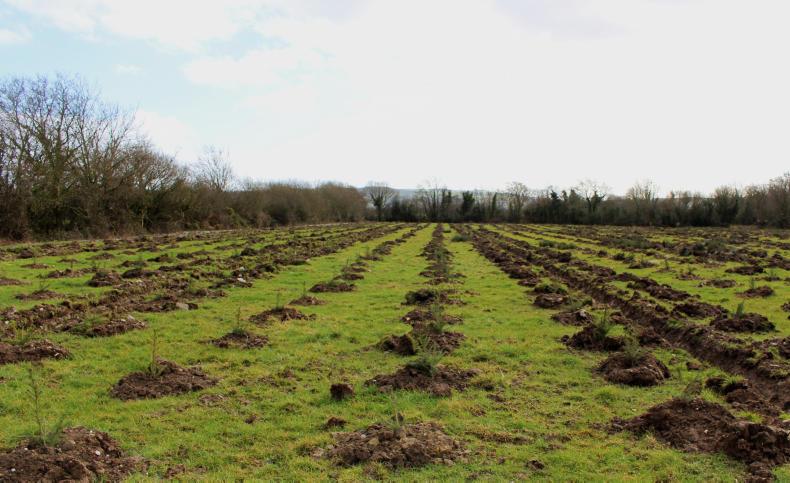Although insect and fungal attack along with fire are serious threats to Irish forests, windthrow is still the greatest source of damage to mature and semi-mature forests. This was illustrated on February 2014 when Storm Darwin caused major damage to forests especially in southern counties.
There is a relationship between thinning regimes and crop stability but drainage is also a key component in windthrow resistance, especially on wet and exposed sites. Trees require a considerable amount of soil moisture to thrive, but waterlogged sites will reduce tree yield while prolonged waterlogging will result in crop failure.
Therefore, crop stability begins at forest establishment when drainage needs to be carried out on most sites in Ireland.
Storm Darwin illustrated the importance of drainage as the damage coincided with periods of prolonged rainfall over the previous three months. Recently, when the massive giant redwood in Yosemite National Park, California – known as the “tunnel tree” was blown, the combination of wind and exceptionally heavy rain was cited as the deciding factor in its demise.
Most coniferous forest trees are relatively shallow rooted so will always be vulnerable to windthrow during heavy storms especially on exposed sites but good drainage helps to increase rooting depth and increase resistance to wind damage.
The Forestry Standards and Procedures Manual issued by the Forest Service recommends a free draining rooting depth of 45-60cm for conifers throughout the year while broadleaves require a greater depth. On mounded sites, the rooting depth is measured from the base of the mound.
Four drain types are constructed prior to planting, comprising, cut off, collector, mound and interceptor drains (Figure 1). These will vary depending on the site, ranging from all four drains on sites that need intensive drainage and close to watercourses to minimal or no drainage on free draining mineral soils.

Cut off drains: These are necessary on sloped sites and are located to direct water away from the afforestation site usually where water is flowing from higher ground.
Collector drains: These are the main site drains (maximum distance apart 80m) and feed in to interceptor drains. As most sites are now mounded, collector drains collect water from mound drains but are also required where other forms of cultivation and drainage are employed such as plough furrows and mole drains. If existing agricultural drains are present, these should be used.
On hill sites, drains should run at angles no greater than 2° (1 in 30) on slopes greater than 3° (1 in 20). The recommended depth is not greater than 10-15cm below the depth of mound drains. “Where collector drains have to be extended into erodible material, ‘mini’ silt traps should be placed appropriately by deepening the drains in places,” maintains the manual.
Sediment transportation to watercourses needs to be minimised or eliminated by installing strategically located sediment traps. “A large number of small sediment traps (located throughout the site) are usually more efficient than a small number of big traps,” the manual states. These need to be regularly monitored and maintained.
Mound drains: Mounding is now the most popular drainage and pre-planting ground cultivation method. Mound drains are fed into collector drains. Their depth and distance apart depends on soil and site conditions. The Forest Service manual recommends a depth of not more than 45cm in mineral soils and 60cm in peat soils, while distance apart varies between 8 and 16m. Close spacing is recommended on sites such as gleys with impeded lateral drainage.
Interceptor drains: These are constructed between collector drain ends and watercourses. They collect water from collector drains and allow it to overflow into the buffer zone. Usually, a buffer or riparian zone – between planted site and watercourse – is managed to encourage natural regeneration.
Drainage and site cultivation should aim to ensure that root structure can develop as deep as possible and spread in all lateral directions.
Correct drainage, at optimum depth and spacing, results in better growing conditions and ensures good anchorage for roots, thus providing greater resistance to windthrow.
Minister Doyle discusses Brexit and exports in Fermoy
Leading timber processing firm Glennon Brothers welcomed Andrew Doyle, Minister of State with responsibility for forestry last week to the company’s Fermoy sawmill.
The Minister wished to inspect the recent €13 million investment in new technology and to hear the views of Pat and Mike Glennon on the forestry and forest products industry. “While I am well aware of the many challenges facing the timber sector I found it really useful to meet the Glennons and hear first-hand their concerns,” the minister said. “The facility in Fermoy is world class and the technology employed to optimise the use of each log is very impressive.”
Mike Glennon told Minister Doyle that as the company imports logs from the UK and exports sawn wood to the UK the issue of Brexit is a key concern. “This will impact not just on Glennons, but on all other sawmills and panel producers in Ireland,” he said. “The sector will be invited to the next all-island sectoral dialogue to tease through the various issues around Brexit which is welcome,” he maintained. “The UK is the largest importer of wood in Europe and this demand will remain post Brexit so it is vital that we address any potential trade barriers between the two countries.”
Pat Glennon stressed the importance of Government support for the forestry sector and looked forward to working with the minister and his staff. “In Ireland we have all the ingredients to have a world class forest product sector,” he said.
Minister Doyle said the Government is committed to investing further in the forestry sector. “I am pleased to see a steady increase in the afforestation levels in the last two years, which will provide the raw material for the sector in the future,” he claimed.






 This is a subscriber-only article
This is a subscriber-only article







SHARING OPTIONS: